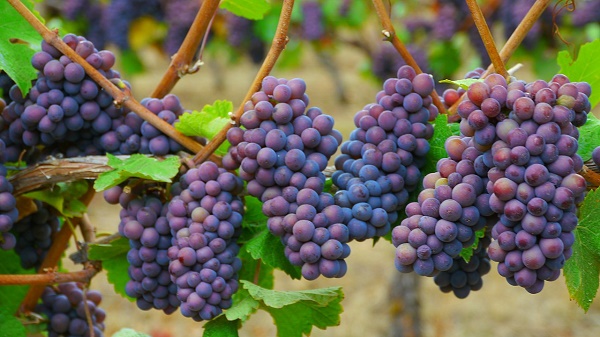World Famous Grapes
Pinot Grigio (Italy)

Pinot Grigio from Italy and Pinot Gris from France (Alsace) is the same grape.
The grape originates from Burgundy in France.
Today its most famous expressions come from Italy and in Alsace (France).
In Germany and Austria it grows under the name of Grauburgunder and Rülander.
Pinot Grigio Flavors
Pinot Grigio wines are usually light, refreshing, and straightforward.
Lemon |
Apple |
Pear |
Flint |
Pinot Gris Flavors
Pinot Gris wines tends to be richer, more complex, with a greater aging potential.
Apple |
Peach |
Flowers |
Spices |
Pinot Grigio in Italy
Crispy Lemon, Apple, and Pear flavors are typical for Pinot Grigio, with hints of Minerals:
Lemon |
Apple |
Pear |
Flint |
Pinot Grigio is a light and dry white wine, refreshing as a cold glass of lemonade on a hot summer day.
It is one of Italy's most popular white wines.
Pinot Grigio is cultivated many places in Italy, but the most prominent regions are in the northeast:
- Veneto
- Trentino
- Alto Adige
- Friuli-Venezia Giulia
Italian Pinot Grigio and French Pinot Gris use the same grapes, but the Italian wine is dry and crisp while the french is sweeter and more aromatic. The Italian grapes are harvested before they mature to reduce sugar in favor of acid.
Two distinctive style differences occur: fresh and light Italian Pinot Grigio, and rich and powerfull French Pinot Gris.
To retain the fruity and citrusy aromas, Pinot Grigio is fermented in Steel Tanks (not in oak).
The Italian Pinot Grigio is suitable for fish and light chicken dishes.
Pinot Grigio is typically dry with a light to medium body. The wine is often crisp and refreshing with high acidity.
Common characteristics include notes of green apple, pear, citrus (lemon, lime) and sometimes a hint of almond. The flavors are usually straightforward and uncomplicated.
Pinot Grigio is often produced in an easy-drinking style. While it can be high quality, it is usually designed for immediate consumption rather than aging. The best examples can exhibit more complexity and balance, but the majority are enjoyed for their freshness and lightness.
Pinot Gris (France)
Apple |
Peach |
Flowers |
Spices |
Pinot Gris generally produces round and full-bodied wines, with moderate acidity, and a pleasant after-taste. Sweet flowers, peaches, and some spice in the character are common in editions where the grapes have become properly ripe.
Pinot Gris can vary significantly in sweetness and body, depending on where and how it is produced. It ranges from dry to off-dry (slightly sweet) and generally has a fuller body compared to Pinot Grigio, with a richer, more rounded mouthfeel.
Pinot Gris often shows more pronounced and complex aromas and flavors than Pinot Grigio. Typical notes include ripe tropical fruits (such as pineapple and mango), stone fruits (like peach and apricot), and a honeyed character. You might also find spicier, earthy, or floral nuances.
Pinot Gris is known for its potential to produce high-quality wines with depth and complexity. It can age well, developing additional layers of flavor over time. The best examples come from Alsace in France, where it can achieve remarkable richness and intensity.
In Alsace, Pinot Gris often replaces red wine and is used (especially if developed) for white meat dishes such as chicken and pig, and also for goose liver.
Pinot Gris in Alsace
Pinot Gris originated in Bourgogne, but has shown its best potential in Alsace.
In Alsace, Pinot Gris is considered a noble grape, where is was first known as Tokaj d'Alsace.
Alsatian Pinot Gris is quite different in taste than those from other regions.
The Alsatian version is typically a little off-dry.
Alsace, located in northeastern France, is characterized by several key natural factors that significantly influence the style of Pinot Gris wines produced in the region.
These natural factors work together to create Pinot Gris wines that are rich, aromatic, and full-bodied, with a potential for aging that sets them apart from their lighter counterparts like Pinot Grigio.
Climate
Alsace has a continental climate with cold winters and warm, dry summers. The region benefits from a long growing season, allowing grapes to ripen fully and develop rich flavors.
Topography
The vineyards are situated along the eastern slopes of the Vosges Mountains. This topography provides excellent sun exposure and drainage, which are crucial for grape quality.
Soil
The soils in Alsace are diverse, including granite, limestone, clay, and volcanic soils. These varied soil types contribute to the complexity and depth of flavors in the wines.
Rainfall
Alsace receives relatively low rainfall, which helps concentrate the flavors in the grapes. The region is also in the rain shadow of the Vosges Mountains, further reducing the risk of excessive moisture.
Pinot Gris in USA
Pinot Gris on the label, indicates a wine made in an off-dry Alsation style.
The first American Pinot Gris vines was planted in in Oregon in 1965.
In 1991, King Estate Winery started to produce quality Oregon Pinot Gris, and managed to developed a US market for the wine.
Today, King Estate Winery is the world's leading producer of premium Pinot Gris from the world's largest organic vineyard of Pinot Gris grapes.
Pinot Gris is also planted in California, where the wine is often called Pinot Grigio because of the similarity in style with Italian Pinot Grigio.
Pinot Grigio in USA
Pinot Grigio on the label, indicates a lighter and more Italian style.
Pinot Gris in Chile
Pinot Gris from Chile is where the Alsatian style meets the Italian style.
Grauburgunder in Germany
Grauburgunder is the German name for Pinot Grigio.
German Grauburgunder is most often associated with dry wine making, like the Italian Pinot Grigio.
Ruländer is found in the Baden and Pfalz regions of Germany, where it is known as a sweet style of Grauburgunder.
The names Grauburgunder and Ruländer are also used in Austria.
Grauburgunder in Austria
High Quality areas / regions:
Burgenland
Steiermark
Grauburgunder (Pinot Grigio) was brought from Burgundy to Austria in the 13th or 14th century by Cistercian monks.
The grape has a high level of sugar and is therefore often vinified in Spätlese or Auslese styles.
The planting of Grauburgunder has been decreasing continuously since 1999.
Pinot Gris in New Zealand
In New Zealand, Pinot Gris is grown in the North and the South Island.
High Quality areas / regions:
Marlborough
Hawke's Bay
In New Zealand, Pinot Gris are more like the Alsatian style.
Pinot Gris is the third most planted white grape after Sauvignon blanc and Chardonnay.
Marlborough in the cooler South Island, produces wines with a great structure, with focus on pure aromatics and flavours of white peach, red apple and cinnamon.
Hawke’s Bay in the warmer climates of the North Island, produces ripe, rich, powerful and concentrated wines in a diversity of styles.
Pinot Gris in Australia
Pinot Gris was first planted in Australia in 1832 from a collection of grapes brought to the island by James Busby (the British Resident in New Zealand).
Australian Pinot Gris can be labeled Pinot Gris (French Type) or Pinot Grigio (Italian Type), depending on the sweetness / dryness of the wine.
Pinot Gris indicates a richer French style.
Pinot Grigio in Australia
Pinot Grigio indicates a lighter and more Italian style.
Factors Contribution to Pinot Gris Styles
Ripeness and Flavor Development
The long, warm growing season allows Pinot Gris grapes to achieve full ripeness, resulting in wines with rich, concentrated flavors. You will often find notes of ripe stone fruits like peach and apricot, along with hints of honey and spice.Aromatic Complexity
The diverse soils and excellent sun exposure contribute to the aromatic complexity of Pinot Gris wines. Expect a bouquet of floral, fruity, and sometimes smoky or earthy notes.Structure and Balance
The well-drained soils and dry climate help produce grapes with balanced acidity and moderate alcohol levels, giving the wines a fresh and lively character.Age-Worthiness
The combination of ripe fruit flavors, balanced acidity, and complex aromas makes Alsace Pinot Gris wines suitable for aging, allowing them to develop additional layers of flavor over time.
Large Oak Barrels
Large, old oak barrels used in Alsace have little influence on the wines' aromas because of two factors:
Size
Larger barrels have a smaller surface area-to-volume ratio compared to smaller barrels. This means less wine comes into contact with the wood, which reduces the transfer of oak flavors and aromas into the wine.Age
Old barrels have already been used multiple times, which means most of the easily extractable flavors and tannins from the wood have already been leached out in previous uses. As a result, old barrels contribute very little in terms of new oak characteristics.
Winemaking Intent
Winemaking Intent result in wines that showcase the distinctive fruit and terroir-driven qualities of Alsace, with minimal influence from the oak:
Preservation of Fruit Character
Winemakers in Alsace often aim to preserve the pure, primary fruit characteristics and the unique expression of their terroir. By using old, large barrels, they can ensure that the oak influence remains subtle, allowing the natural fruit flavors and aromas of the grapes to shine through.Gentle Oxygenation
Old, large barrels still allow for a controlled, gentle oxygenation process, which can help to round out the wine and add complexity without imparting strong oak flavors. This method helps to enhance the texture and integrate the wine's components without overshadowing the inherent varietal and regional characteristics.
